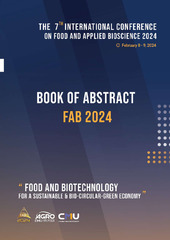Приказ основних података о документу
Phenolic profile of Serbian old wheat local landraces and locally adapted varieties
| dc.creator | Mišan, Aleksandra | |
| dc.creator | Radić, Bojana | |
| dc.creator | Maravić, Nikola | |
| dc.creator | Pojić, Milica | |
| dc.creator | Tomić, Jelena | |
| dc.creator | Hadnađev, Miroslav | |
| dc.creator | Mikić, Sanja | |
| dc.date.accessioned | 2024-02-29T13:20:53Z | |
| dc.date.available | 2024-02-29T13:20:53Z | |
| dc.date.issued | 2024 | |
| dc.identifier.uri | http://fiver.ifvcns.rs/handle/123456789/4309 | |
| dc.description.abstract | Wheat is one of the most important staple crops in Serbia and plays an important role in food security and nutrition. Phenolic compounds are dominant antioxidants in whole grains and are essential quality traits in future breeding programs as they are known for their beneficial cffects on health. With the aim of analyzing local wheat diversity in terms of phenolic compounds, 33 local landraces and old locally adapted varieties and 3 modern wheat varieties were grown in 2021/2022. So, the objective of this work was to optimize the extraction of phenolic compounds and analyze them by HPLC/DAD method and compare old with modern cultivars. As it is known that cereal grains contain different phenolic compounds, mainly phenolic acids in bound form, the extraction of phenolic compounds was done from wholemeal flour samples after hydrolysis. Alkaline hydrolysis conducted at 25°C for 12 h using a 2 M NaOH solution in water demonstrated greater efficiency compared to employing solutions of up to 10 M KOH in methanol under the same temperature and duration. HPLCDAD analysis revealed that ferulic acid presents the major phenolic compound both in old and modern wheat samples ranging between 14 and 149 mg/kg in old and 51 and 61 mg/kg in modern varieties. Apart from ferulic acid, vanillic acid (3.1-11.5 mg/kg), syringic acid (1.4-5.5 mg/kg) and p-coumaric acid (1-6.9 mg/kg) were identified and quantified in old, but not in new varieties. Our results indicate that the genetic potential of old varieties in terms of polyphenolic compounds is not fully utilized because the content of ferulic acid in whole grains in some samples is almost three times higher than in modern varieties that do not differ significantly among themselves. | sr |
| dc.language.iso | en | sr |
| dc.publisher | Chiang Mai : Chiang Mai University, Faculty of Agro-Industry | sr |
| dc.relation | FAO project: Redesigning the exploitation of small grains genetic resources towards increased sustainability of grain-value chain and improved farmers’ livelihoods in Serbia and Bulgaria – GRAINEFIT; 2019-2022 | sr |
| dc.rights | openAccess | sr |
| dc.rights.uri | https://creativecommons.org/licenses/by/4.0/ | |
| dc.source | Book of Abstract, 7th International Conference on Food and Applied Bioscience (FAB 2024) "Food and Biotechnology for a Sustainable and Bio-Circular-Green Economy", 8-9 February 2024, Chiang Mai, Thailand | sr |
| dc.subject | wheat | sr |
| dc.subject | Phenolic profile | sr |
| dc.subject | Ferulic acid | sr |
| dc.subject | HPLC | sr |
| dc.title | Phenolic profile of Serbian old wheat local landraces and locally adapted varieties | sr |
| dc.type | conferenceObject | sr |
| dc.rights.license | BY | sr |
| dc.citation.spage | 77 | |
| dc.identifier.fulltext | http://fiver.ifvcns.rs/bitstream/id/11543/bitstream_11543.pdf | |
| dc.identifier.rcub | https://hdl.handle.net/21.15107/rcub_fiver_4309 | |
| dc.type.version | publishedVersion | sr |


